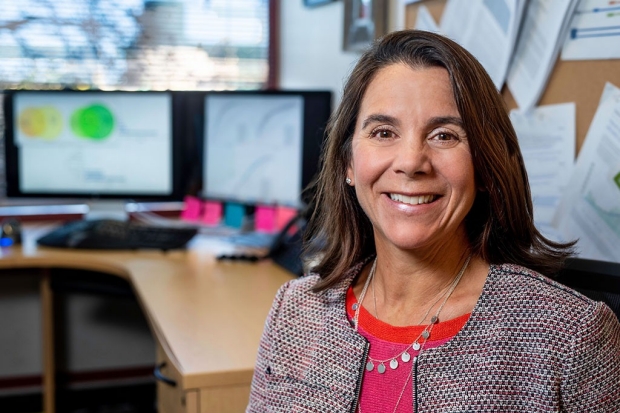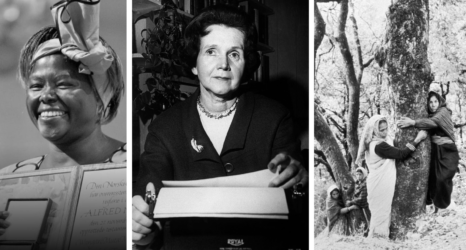For Dr. Tina Hernandez-Boussard, solving inequities in healthcare is only possible when the people who collect, analyze and interpret data to make decisions, are as diverse as those affected by those decisions.

Growing up in a rural community, Tina Hernandez-Boussard never thought she would go on to earn a Ph.D., much less be at the forefront of a new field intent on solving the inequities of our healthcare system through data science. However, with the support of a mentor who recognized her potential and encouraged her pursuits, Dr. Hernandez-Boussard—now a professor of medicine and biomedical data science at Stanford University—leads efforts utilizing data in medicine to better serve people from all demographics, not only those who have traditionally been the focus of biomedical research.
For Hernandez-Boussard, solving the inequities within our healthcare system is only possible when we ensure that the people who collect, analyze and interpret data to make decisions, are as diverse as those who will be affected by those decisions. Not only does this make healthcare more equitable, it also creates more empathetic medicine. Through merging health and data science, Hernandez-Boussard is uniquely situated to understand both the challenges and the opportunities in biomedicine that she and other advocates for equity in health care confront. In the wake of a pandemic that drew attention to the numerous inequities in our healthcare system for minority and low-income populations, solving these problems is not only an academic venture, but a matter of life and death.
As Hernandez-Boussard observed at last month’s Women in Data Science Conference at Stanford University, one of the greatest challenges for data science in healthcare is also its greatest opportunity: creating datasets that include populations and perspectives traditionally excluded from medicine and medical research. Although data science can offer important insights into the problems we face, Hernandez-Boussard reminds us data analysis techniques, like natural language processing (an interdisciplinary approach to computer science that scrapes human language for data) and machine learning, only provide answers learned from the data we feed it. When that data is unbalanced, models perform poorly for different populations.
For example, the Boussard Lab has been working to identify depressive symptoms in cancer patients undergoing chemotherapy. While it is relatively straightforward to capture symptoms of severely depressed patients, intermediate symptoms are less easy to discern, especially among diverse populations who might express these symptoms or feelings differently and traditionally haven’t been researched. Diverse data scientists have the background to understand how people might communicate these symptoms across culture, gender, race, language and socioeconomic groups. To ask the right questions, data science needs to have diverse problem-solving teams who can better understand patients’ voices.
According to Hernandez-Boussard, one of the best ways to improve data-driven medicine is to ensure diverse teams of scientists and clinicians are thinking about the right questions to ask. For example, Hernandez-Boussard recalls the time a hospital asked for an algorithm to predict no-show appointments. Rather than simply creating such an algorithm, Hernandez-Boussard’s team challenged the hospital to think about why they wanted to predict no-shows instead of using data to find ways to reduce barriers that prevent patients from keeping their appointments. In this case, what “worked best” for the hospital perpetuated circumstances which restrict certain populations from accessing healthcare.
To ask the right questions, data science needs to have diverse problem-solving teams who can better understand patients’ voices.
Working with diverse populations allows scientists to challenge preconceived notions of symptoms, diseases and treatments, while also enabling practitioners and patients to work together to overcome histories of harm and misinformation. For data science to effectively rise to the challenge of unraveling bias in healthcare, the task requires an additional type of diversity. Not only must data scientists ensure diverse patient voices are better incorporated into healthcare systems, but data science as a field must also seek strategies for creating diverse team science approaches to problem solving.
In addition to ensuring diversity in gender, race, ethnicity and ability in biomedical data science, Hernandez-Boussard emphasizes the importance of diversity within backgrounds, professions and fields of study among teams of those studying problems in medicine. Collaboration across fields is critical, because the complexities of contemporary science and the problems confronting healthcare require multidisciplinary relationships; with computer scientists partnering with clinicians, engineers working with statisticians and social scientists bringing insights from qualitative research.
Data scientists can only rise to the challenge of healthcare inequality and become more collaborative and creative problem solvers by listening to diverse patient voices and engaging in conversations with those who push them outside their comfort zones. As lives continue to be lost as a result of incomplete data sets and single-minded solutions, Hernandez-Boussard’s efforts to diversify data in healthcare have the potential to save the lives of many people who have traditionally been left behind by medicine.
Up next:





